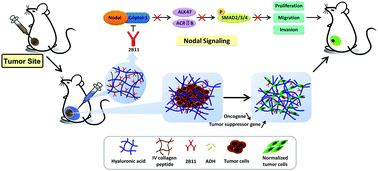Hydrogels bearing bioengineered mimetic embryonic microenvironments for tumor reversion†
Abstract
Embryonic microenvironments can reverse the metastatic phenotype of aggressive tumors by inhibiting the Nodal signaling pathway. Here, we hypothesize that embryonic microenvironments can be transplanted for the purpose of oncotherapy. We report the development of an injectable bioactive hydrogel system containing the key antagonists of Nodal signaling—Cripto-1 receptor antibodies (2B11)—for the creation of embryonic microenvironments and the examination of their effect on tumor reversion treatment using a mouse model. Our in vitro results show that the hydrogel system can reduce the mitochondrial membrane potential of MDA-MB-231 and MCF-7, promote cell apoptosis, and reduce the invasive ability of cells. Our in vivo results illustrate that the hydrogel system can significantly inhibit tumor growth in both breast cancer and melanoma tumor-bearing mouse models, as well as transform the cell morphology of melanoma B16 cells to melanin-like cells. Furthermore, the results of the up-regulation of tumor suppressor genes and the down-regulation of oncogenes by high-throughput sequencing confirm that the developed system can also selectively turn on some tumor suppressor genes and turn off certain oncogenes so as to prompt the benign reversion of the tumor phenotype. Taken together, our results demonstrate the injectable biomaterial system is able to create an effective microenvironment for melanoma and breast tumor therapy.


 Please wait while we load your content...
Please wait while we load your content...